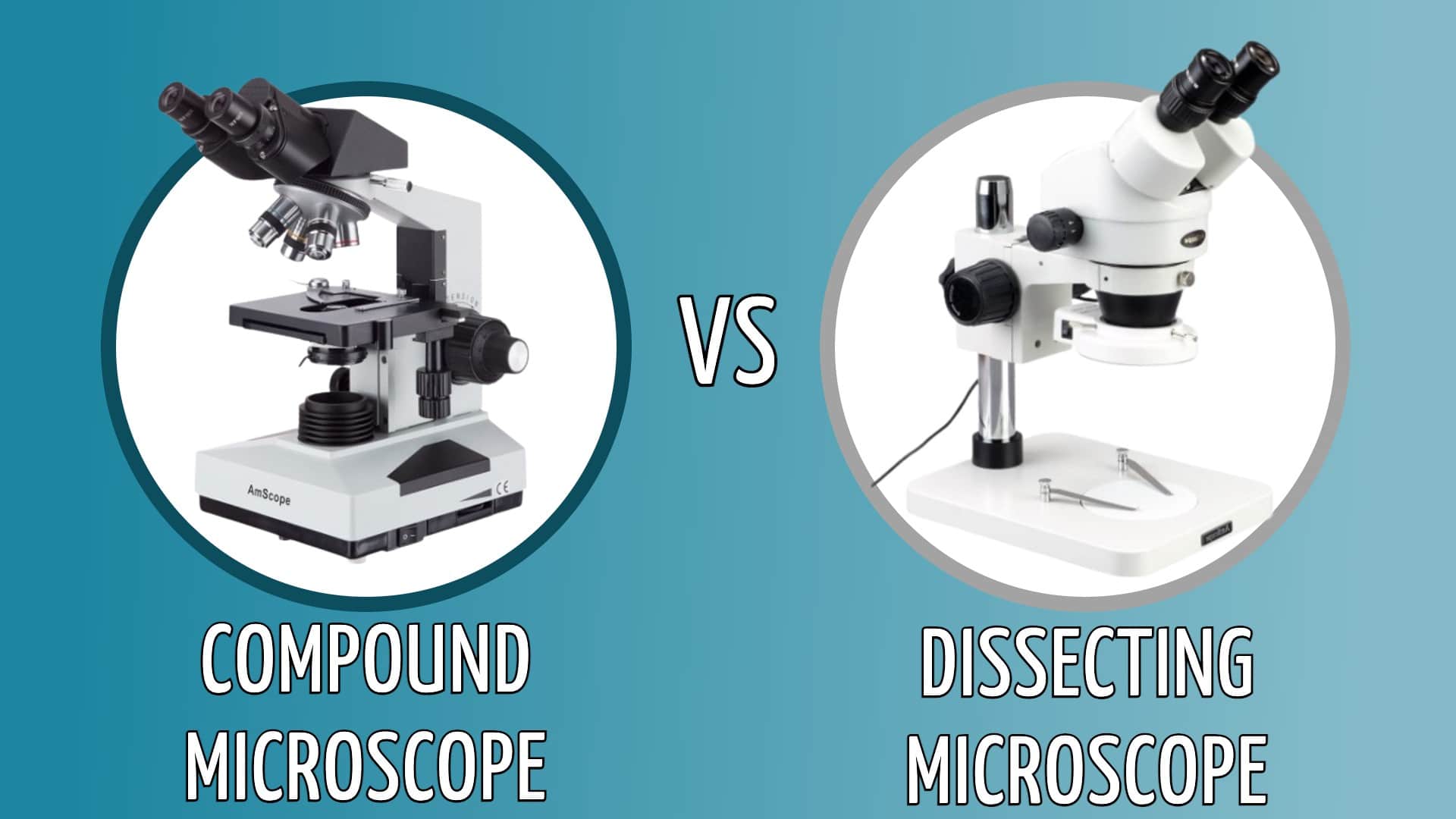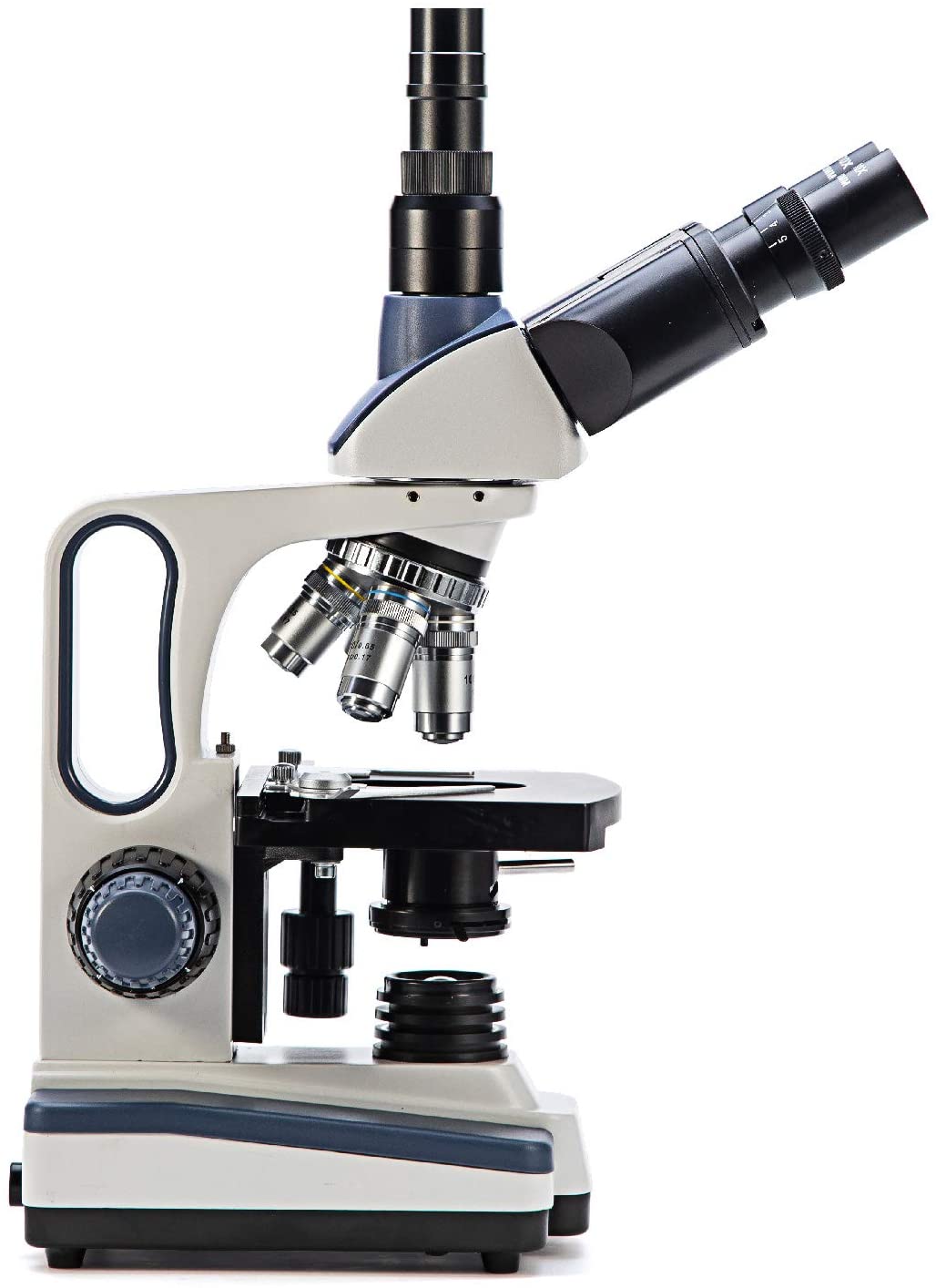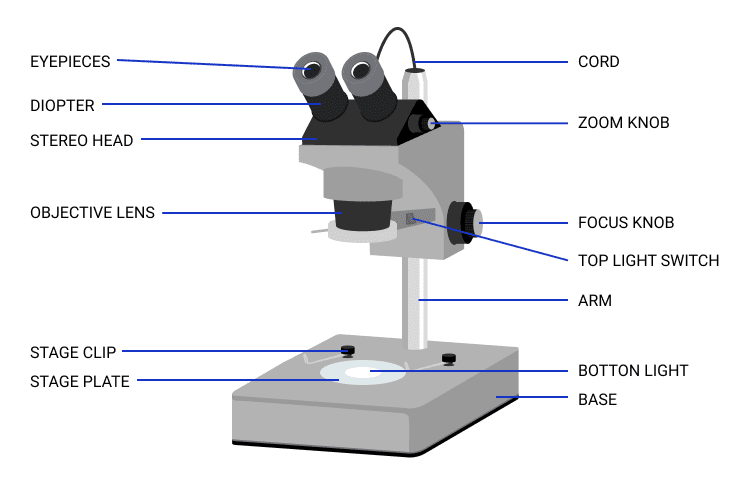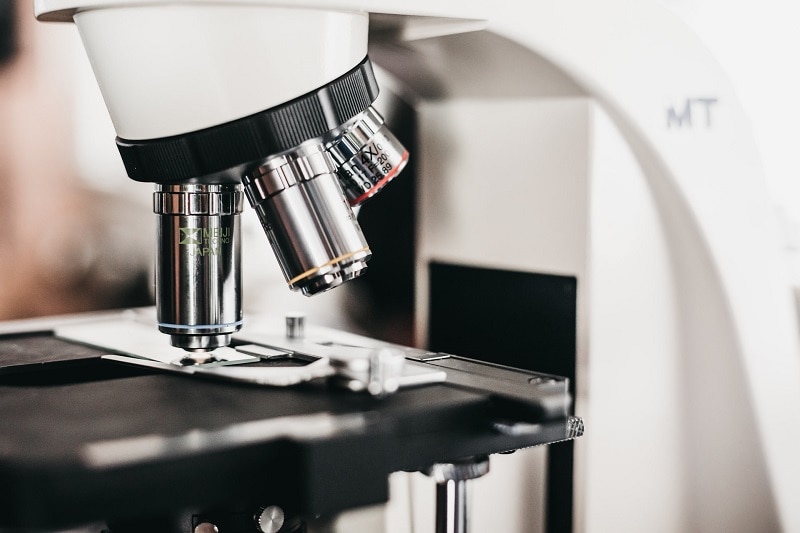Compound Vs. Dissecting Microscope: What’s the Difference?
Last Updated on

Introduction
The world of microscopy is divided into two main categories: compound microscopy and dissecting microscopy. These types of microscopes are quite different and serve very different purposes, but which one is which? They are a lot alike (after all, they both make small things look bigger), but they are designed from the ground up for their unique purpose.
We are going to go over all the key differences between these two different types of microscopes, talk about how they work, what they’re for, and what they will not work well for. Let’s begin!

Overview of Compound Microscopes

A compound microscope will provide magnification between 40x and 1000x and is used to view things that are not visible to the naked eye.
How it Works
With a compound microscope, your primary light source is underneath the item you are examining (usually called a specimen). The specimen is stained with dyes to make each feature stand out more clearly, and the light shines up through the dyed specimen and into the objective lens. A compound microscope will have multiple objective lenses that you can switch to change the magnification level.
Typically, the four objective lenses are 4x, 10x, 40x, and 100x. As the light passes through the microscope, it hits another magnifier with a power of 10x so the image that finally reaches your eye is magnified at 40x, 100x, 400x, or 1000x.

When to Choose
This makes compound microscopes ideal when you need to look at something so small that you can’t see it with your naked eye. For the microscope to work properly, the specimen also needs to be at least partially translucent so that the light can pass through and make it visible.
Since the magnification needs to be so high, the space between the specimen and the objective lens (called the working area), is quite small, no larger than 4 millimeters. This means that when using a compound microscope, you’ll be observing only, not interacting with or dissecting the specimen.
When Not to Choose
Compound microscopes are not good when you are trying to get a good view of a relatively large object. If you are examining the wings of a bumblebee, for example, or examining gemstones, a compound microscope would not be a good solution most of the time.
They are also not powerful enough to see specimens that require more than 1000x magnification, like a virus or anything on the molecular or atomic levels.
- High magnification
- Switchable objectives for different magnification power
- Can be used to see things not visible to the naked eye
- Working area too small to interact with specimen
- Only works with translucent objects
- Cannot see on a molecular level
- You might also be interested in: Stereo vs. Compound Microscopes: What’s The Difference?

Overview of Dissecting Microscopes:
Dissecting microscopes are also known as stereo microscopes. As the name would imply, these microscopes are used when you need to dissect or see intricate details of an object.

How it Works
A dissecting microscope has one objective lens. There is no light source positioned directly underneath the object and the microscope relies on the light bouncing off the specimen and into the lens for visibility. The light passes through the microscope and out to the two eyepieces, giving you a 3D image of what you’re working with.
For a stereo microscope, magnification can be as low as 6x and as high as 70x, and they come in two types: fixed power and zoom power. A fixed power dissecting microscope is set at a certain magnification and cannot change, while a zoom power microscope is able to shift from the lowest magnification to the highest magnification.
When to Choose
Dissecting microscopes are best for items that you can see with your naked eye, are opaque, and that you want to interact with while you’re examining. These are often used by people working on electronics, watches, or those wanting to see details on an object such as the wings of an insect.
A scientist dissecting a small insect, animal, or plant could use a dissecting microscope to get a much better understanding of the details. The working area is much larger than a compound microscope and can give you up to 150 millimeters (about 6 inches).
When Not to Choose
Dissecting microscopes is not good when you need to see things that are so small that you can’t see them with your naked eye. They are not powerful enough to give you useful detail on specimens that small. Even if you have a dissecting microscope with a power above 40x, the way the microscope processes the light just isn’t designed to give good results for specimens that small.
- The large working area allows for interaction
- Can see images in 3D
- Full-color
- Can’t be used for anything really small
- The magnification range is limited

Additional Information
What Type of Microscope Do You Need?
If you want to look at microscopic (pun intended) things, you’ll need a compound microscope to do that, but it will only work if the specimen is at least partially translucent. Opaque items usually appear as solid black in a compound microscope.
If you want to look at the things around you closer and see the details in your clothing, hair, or comb, then the dissecting microscope is what you’ll want.
Compound microscopes are generally more expensive than dissecting microscopes because they require much more complicated optics internally to achieve such high magnification while maintaining sharp focus.

What Other Types of Microscopes Are There?
This depends on how they’re being categorized, but besides compound and dissection, the other two main types are confocal microscopes and electron microscopes. A confocal microscope has a similar magnification range to a compound microscope, but uses a laser light as its illumination source and gives a very different image.
An electron microscope is what is used to view specimens on molecular and atomic levels. You can get 3D and 2D images depending on what type of electron microscope you have. Electron microscopes are prohibitively expensive.

Final Thoughts
It is important that you get the right microscope for what you are wanting to observe. For most hobbyists, a dissecting microscope will provide plenty of opportunities to see things much closer. If you want to see the cell structure of a plant or the different components of a human blood cell, though, you’ll need a compound microscope.
About the Author Robert Sparks
Robert’s obsession with all things optical started early in life, when his optician father would bring home prototypes for Robert to play with. Nowadays, Robert is dedicated to helping others find the right optics for their needs. His hobbies include astronomy, astrophysics, and model building. Originally from Newark, NJ, he resides in Santa Fe, New Mexico, where the nighttime skies are filled with glittering stars.
Related Articles:
How to Clean a Refractor Telescope: Step-by-Step Guide
How to Clean a Telescope Eyepiece: Step-by-Step Guide
How to Clean a Rifle Scope: 8 Expert Tips
Monocular vs Telescope: Differences Explained (With Pictures)
What Is a Monocular Used For? 8 Common Functions
How to Clean a Telescope Mirror: 8 Expert Tips
Brightfield vs Phase Contrast Microscopy: The Differences Explained
SkyCamHD Drone Review: Pros, Cons, FAQ, & Verdict
